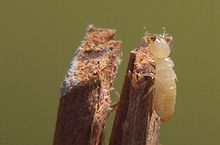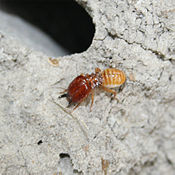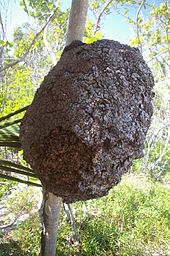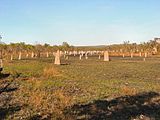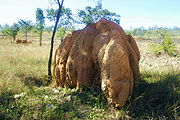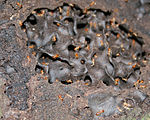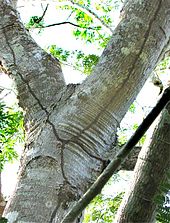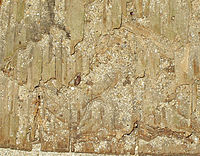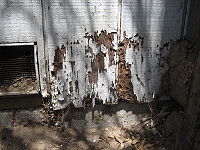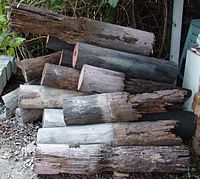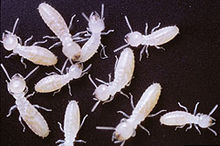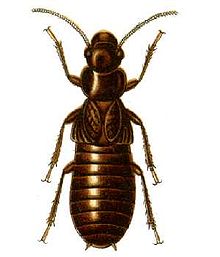
Termite
About this schools Wikipedia selection
The articles in this Schools selection have been arranged by curriculum topic thanks to SOS Children volunteers. Sponsoring children helps children in the developing world to learn too.
| Termite Temporal range: 228–0Ma Late Triassic - Recent |
|
|---|---|
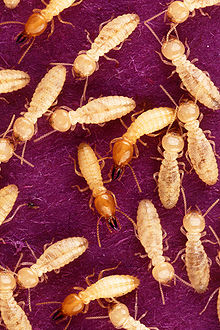 |
|
| Formosan subterranean termite soldiers (red colored heads) and workers (pale colored heads). | |
| Scientific classification | |
| Kingdom: | Animalia |
| Phylum: | Arthropoda |
| Class: | Insecta |
| Subclass: | Pterygota |
| Infraclass: | Neoptera |
| Superorder: | Dictyoptera |
| Order: | Blattodea |
| (unranked): | Termitoidae |
| Families | |
|
Mastotermitidae |
|
Termites are a group of eusocial insects that, until recently, were classified at the taxonomic rank of order Isoptera (see taxonomy below), but are now accepted as the epifamily Termitoidae, of the cockroach order Blattodea. While termites are commonly known, especially in Australia, as "white ants", they are only distantly related to the ants.
Like ants, and some bees and wasps—which are all placed in the separate order Hymenoptera—termites divide labor among castes, produce overlapping generations and take care of young collectively. Termites mostly feed on dead plant material, generally in the form of wood, leaf litter, soil, or animal dung, and about 10% of the estimated 4,000 species (about 2,600 taxonomically known) are economically significant as pests that can cause serious structural damage to buildings, crops or plantation forests. Termites are major detritivores, particularly in the subtropical and tropical regions, and their recycling of wood and other plant matter is of considerable ecological importance.
As eusocial insects, termites live in colonies that, at maturity, number from several hundred to several million individuals. Colonies use decentralised, self-organised systems of activity guided by swarm intelligence which exploit food sources and environments unavailable to any single insect acting alone. A typical colony contains nymphs (semimature young), workers, soldiers, and reproductive individuals of both sexes, sometimes containing several egg-laying queens.
Social organization
Reproductives
At maturity, a primary queen has a great capacity to lay eggs. In some species, the mature queen has a greatly distended abdomen and may produce 20000 to 30000 eggs a day. The two mature ovaries may have some 2000 ovarioles each. The abdomen increases the queen's body length to several times more than before mating and reduces her ability to move freely, though attendant workers provide assistance. The queen is widely believed to be a primary source of pheromones useful in colony integration, and these are thought to be spread through shared feeding ( trophallaxis).
The king grows only slightly larger after initial mating and continues to mate with the queen for life (a termite queen can live for 45 years). This is very different from ant colonies, in which a queen mates once with the male(s) and stores the gametes for life, as the male ants die shortly after mating.
The winged (or "alate") caste, also referred to as the reproductive caste, are generally the only termites with well-developed eyes, although workers of some harvesting species do have well-developed compound eyes, and, in other species, soldiers with eyes occasionally appear. Termites on the path to becoming alates going through incomplete metamorphosis form a subcaste in certain species of termites, functioning as workers " pseudergates" and also as potential supplementary reproductives. Supplementaries have the ability to replace a dead primary reproductive and, at least in some species, several are recruited once a primary queen is lost.
In areas with a distinct dry season, the alates leave the nest in large swarms after the first soaking rain of the rainy season. In other regions, flights may occur throughout the year, or more commonly, in the spring and autumn. Termites are relatively poor fliers and are readily blown downwind in wind speeds of less than 2 km/h, shedding their wings soon after landing at an acceptable site, where they mate and attempt to form a nest in damp timber or earth.
Workers
Worker termites undertake the labors of foraging, food storage, brood and nest maintenance, and some defense duties in certain species. Workers are the main caste in the colony for the digestion of cellulose in food and are the most likely to be found in infested wood. This is achieved in one of two ways. In all termite families, except the Termitidae, flagellate protists in the gut assist in cellulose digestion. However, in the Termitidae, which account for approximately 60% of all termite species, the flagellates have been lost and this digestive role is taken up, in part, by a consortium of prokaryotic organisms. This simple story, which has been in entomology textbooks for decades, is complicated by the finding that all studied termites can produce their own cellulase enzymes, and therefore might digest wood in the absence of their symbiotic microbes, although new evidence suggests these gut microbes make use of termite-produced cellulase enzymes. Our knowledge of the relationships between the microbial and termite parts of their digestion is still rudimentary. What is true in all termite species, however, is the workers feed the other members of the colony with substances derived from the digestion of plant material, either from the mouth or anus. This process of feeding of one colony member by another is known as trophallaxis, and is one of the keys to the success of the group. It frees the parents from feeding all but the first generation of offspring, allowing for the group to grow much larger and ensuring the necessary gut symbionts are transferred from one generation to another. Some termite species do not have a true worker caste, instead relying on nymphs that perform the same work without differentiating as a separate caste.
Soldiers
The soldier caste has anatomical and behavioural specializations, providing strength and armour which are primarily useful against ant attack. The proportion of soldiers within a colony varies both within and among species. Many soldiers have jaws so enlarged, they cannot feed themselves, but instead, like juveniles, are fed by workers. The pantropical subfamily Nasutitermitinae have soldiers with the ability to exude noxious liquids through a horn-like nozzle (nasus). Simple holes in the forehead, fontanelles, exuding defensive secretions are a feature of the family Rhinotermitidae. Many species are readily identified using the characteristics of the soldiers' heads, mandibles, or nasi. Among the drywood termites, a soldier's globular (phragmotic) head can be used to block their narrow tunnels. Termite soldiers are usually blind, but in some families, particularly among the dampwood termites, soldiers developing from the reproductive line may have at least partly functional eyes.
The specialization of the soldier caste is principally a defence against predation by ants. The wide range of jaw types and phragmotic heads provides methods that effectively block narrow termite tunnels against ant entry. A tunnel-blocking soldier can rebuff attacks from many ants. Usually more soldiers stand by behind the initial soldier so once the first one falls another soldier will take the place. In cases where the intrusion is coming from a breach that is larger than the soldier's head, defence requires special formations where soldiers form a phalanx-like formation around the breach and bite at intruders or exude toxins from the nasus or fontanelle. This formation involves self-sacrifice because once the workers have repaired the breach during fighting, no return is provided, thus leading to the death of all defenders. Another form of self-sacrifice is performed by Southeast Asian tar baby termites ( Globitermes sulphureus). The soldiers of this species commit suicide by autothysis—rupturing a large gland just beneath the surface of their cuticles. The thick, yellow fluid in the gland becomes very sticky on contact with the air, entangling ants or other insects which are trying to invade the nest.
Termites undergo incomplete metamorphosis. Freshly hatched young appear as tiny termites that grow without significant morphological changes (other than wings and soldier specializations). Some species of termites have dimorphic soldiers (up to three times the size of smaller soldiers). Though their value is unknown, they may function as an elite class that defends only the inner tunnels of the mound. Evidence for this is, even when provoked, these large soldiers do not defend themselves, but retreat deeper into the mound. On the other hand, dimorphic soldiers are common in some Australian species of Schedorhinotermes that neither build mounds nor appear to maintain complex nest structures. Some termite taxa are without soldiers; perhaps the best known of these are in the Apicotermitinae.
Diet
Termites are generally grouped according to their feeding behaviour. Thus, the commonly used general groupings are subterranean, soil-feeding, drywood, dampwood, and grass-eating. Of these, subterraneans and drywoods are primarily responsible for damage to human-made structures.
All termites eat cellulose in its various forms as plant fibre. Cellulose is a rich energy source (as demonstrated by the amount of energy released when wood is burned), but remains difficult to digest. Termites rely primarily upon symbiotic protozoa ( metamonads) such as Trichonympha, and other microbes in their guts to digest the cellulose for them and absorb the end products for their own use. Gut protozoa, such as Trichonympha, in turn, rely on symbiotic bacteria embedded on their surfaces to produce some of the necessary digestive enzymes. This relationship is one of the finest examples of mutualism among animals. Most so-called higher termites, especially in the family Termitidae, can produce their own cellulase enzymes. However, they still retain a rich gut fauna and primarily rely upon the bacteria. Owing to closely related bacterial species, it is strongly presumed that the termites' gut flora are descended from the gut flora of the ancestral wood-eating cockroaches, like those of the genus Cryptocercus.
Some species of termite practice fungiculture. They maintain a “garden” of specialized fungi of genus Termitomyces, which are nourished by the excrement of the insects. When the fungi are eaten, their spores pass undamaged through the intestines of the termites to complete the cycle by germinating in the fresh faecal pellets. They are also well known for eating smaller insects in a last resort environment.
A recent study by Australian scientists found that termites have been found to excrete trace deposits of gold. According to the CSIRO, the termites burrow beneath eroded subterranean material which typically masks human attempts to find gold, and ingest and bring the new deposits to the surface. They believe that studying termite nests may lead to less invasive methods of finding gold deposits.
Nests
Termite workers build and maintain nests which house the colony. These are elaborate structures made using a combination of soil, mud, chewed wood/cellulose, saliva, and faeces. A nest has many functions such as providing a protected living space and water conservation (through controlled condensation). There are nursery chambers deep within the nest where eggs and first instar larvae are tended. Some species maintain fungal gardens that are fed on collected plant matter, providing a nutritious mycelium on which the colony then feeds (see Diet, above). Nests are punctuated by a maze of tunnel-like galleries that provide air conditioning and control the CO2/O2 balance, as well as allow the termites to move through the nest.
Nests are commonly built underground, in large pieces of timber, inside fallen trees, or atop living trees. Some species build nests above ground, and they can develop into mounds. Homeowners need to be careful of tree stumps that have not been dug up. These are prime candidates for termite nests and being close to homes, termites usually end up destroying the siding and sometimes even wooden beams.
Mounds
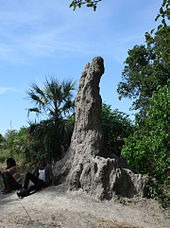
Mounds (also known as "termitaria") occur when an aboveground nest grows beyond its initially concealing surface. They are commonly called “ant hills” in Africa and Australia, despite the technical incorrectness of that name.
In tropical savannas, the mounds may be very large, with an extreme of 9 m (30 ft) high in the case of large conical mounds constructed by some Macrotermes species in well-wooded areas in Africa. Two to three metres, however, would be typical for the largest mounds in most savannas. The shape ranges from somewhat amorphous domes or cones usually covered in grass and/or woody shrubs, to sculptured hard-earth mounds, or a mixture of the two. Despite the irregular mound shapes, the different species in an area can usually be identified by simply looking at the mounds.
The sculptured mounds sometimes have elaborate and distinctive forms, such as those of the compass termite (Amitermes meridionalis and A. laurensis) which build tall, wedge-shaped mounds with the long axis oriented approximately north–south, which gives them their common name. This orientation has been experimentally shown to assist thermoregulation. The thin end of the nest faces towards the sun at its peak intensity, hence taking up the least possible heat, and allows these termites to stay above ground where other species are forced to move into deeper below ground areas. This also allows the compass termites to live in poorly drained areas where other species would be caught between a choice of baking or drowning. The column of hot air rising in the aboveground mounds helps drive air circulation currents inside the subterranean network. The structure of these mounds can be quite complex. The temperature control is essential for those species that cultivate fungal gardens and even for those that do not; much effort and energy is spent maintaining the brood within a narrow temperature range, often only plus or minus 1° Celsius over a day.
In some parts of the African savanna, a high density of aboveground mounds dominates the landscape. For instance, in some parts of the Busanga Plain area of Zambia, small mounds of about 1 m diameter with a density of about 100 per hectare can be seen on grassland between larger tree- and bush-covered mounds about 25 m in diameter with a density around 1 per hectare, and both show up well on high-resolution satellite images taken in the wet season.
-
Cathedral Mounds in the Northern Territory of Australia
-
Termites in a mound, Analamazoatra Reserve, Madagascar
Shelter tubes
Termites are weak and relatively fragile insects that need to stay moist to survive. They can be overpowered by ants and other predators when exposed. They avoid these perils by covering their trails with tubing made of feces, plant matter, saliva, and soil. Thus, the termites can remain hidden and wall out unfavourable environmental conditions. Sometimes these shelter tubes will extend for many metres, such as up the outside of a tree reaching from the soil to dead branches.
To subterranean termites, any breach of their tunnels or nests is a cause for alarm. When the Formosan subterranean termite (Coptotermes formosanus) and the eastern subterranean termite (Reticulitermes flavipes) detect a potential breach, the soldiers will usually bang their heads apparently to attract other soldiers for defence and recruit additional workers to repair any breach. This head-banging response to vibration is also useful when attempting to locate termites in house frames.
Human interaction
Timber damage
Owing to their wood-eating habits, many termite species can do great damage to unprotected buildings and other wooden structures. Their habit of remaining concealed often results in their presence being undetected until the timbers are severely damaged and exhibit surface changes. Once termites have entered a building, they do not limit themselves to wood; they also damage paper, cloth, carpets, and other cellulosic materials. Particles taken from soft plastics, plaster, rubber, and sealants such as silicone rubber and acrylics are often employed in construction.
Humans have moved many wood-eating species between continents, but have also caused drastic population decline in others through habitat loss and pesticide application.
Termites are commonly viewed as pests in many countries, because of the damage they can cause to structures and similar nuisances. In April 2011, wood-eating termites were blamed for reportedly consuming more than $220,000 worth of Indian rupee notes.
Precautions:
- Avoid contact of susceptible timber with the ground by using termite-resistant concrete, steel, or masonry foundations with appropriate barriers. Even so, termites are able to bridge these with shelter tubes, and it has been known for termites to chew through piping made of soft plastics and even some metals, such as lead, to exploit moisture. In general, new buildings should be constructed with embedded physical termite barriers so no easy means remain for termites to gain concealed entry. While barriers of poisoned soil, so-called termite pre-treatment, have been in general use since the 1970s, it is preferable that these be used only for existing buildings without effective physical barriers.
- The intent of termite barriers (whether physical, poisoned soil, or some of the new poisoned plastics) is to prevent the termites from gaining unseen access to structures. In most instances, termites attempting to enter a barriered building will be forced into the less favourable approach of building shelter tubes up the outside walls; thus, they can be clearly visible both to the building occupants and a range of predators.
- Timber treatment
- Use of timber that is naturally resistant to termites, such as Syncarpia glomulifera (turpentine tree), Tectona grandis (teak), Callitris glaucophylla (white cypress), or one of the sequoias. No tree species has every individual tree yielding only timbers that are immune to termite damage, so even with well-known termite-resistant timber types, pieces occasionally will be attacked.
When termites have already penetrated a building, the first action is usually to destroy the colony with insecticides before removing the termites' means of access and fixing the problems that encouraged them in the first place. Baits (feeder stations) with small quantities of disruptive insect hormones or other very slow-acting toxins have become the preferred, least-toxic management tool in most western countries. This has replaced the dusting of toxins direct into termite tunnels that had been widely done since the early 1930s (originating in Australia). The main dust toxicants have been the inorganic metallic poison arsenic trioxide, insect growth regulators (hormones such as triflumuron), and more recently fipronil, a phenyl-pyrazole. Blowing dusts into termite workings is a highly skilled process. All these slow-acting poisons can be distributed by the workers for hours or weeks before any symptoms occur and are capable of destroying the entire colony. More modern variations include chlorfluazuron, diflubenzuron, hexaflumuron, and novaflumuron as bait toxicants, and fipronil, imidacloprid, and chlorantraniprole as soil poisons. Soil poisons are the least-preferred method of control, as this requires large doses of toxin and results in uncontrollable release to the environment.
The termites' effects are damaging, costing the southwestern United States approximately $1.5 billion each year in wood structure damage. To better control the population of termites, researchers at the Agricultural Research Service have found a way to track the movement of the destructive pests. In 1990, researchers found a way to safely and reliably track termites using immunoglobulin G (IgG) marker proteins from rabbits or chickens. In field tests, termite bait was laced with the rabbit IgG and the termites were randomly exposed to feeding on this bait. Termites were later collected from the field and tested for the rabbit-IgG markers using a rabbit-IgG-specific assay. However, this method of testing for the tracking proteins is expensive. Recently, researchers have developed a new way of tracking the termites using egg white, cow milk, or soy milk proteins, which can be sprayed on the termites in the field. This new method is less expensive because the proteins can be traced using a protein-specific ELISA test. The ELISA test is more affordable, because it is designed for mass production. Researchers hope to use this method of tracking termites to find a more cost-effective way to control the damaging pests.
Termites in the human diet
People have eaten termites in many cultures. Africa in particular seems to be the centre of termite eating. The alates have been so important a component in the diet of native African populations, most relevant authors remarked on the fact. Different communities had different methods of collecting or even cultivating the insects, but most of them favoured the alates, though some also collected the soldiers of some species. Queens are harder to acquire, but are widely regarded as a delicacy when available. The insects certainly are nutritious, having a good store of fat and protein, and are palatable in most species, with a nutty flavour when cooked. They are easily gathered at the beginning of the rainy season in West, Central and Southern Africa when they swarm, as they are attracted to lights and can be gathered up when they land on nets put up around a lamp. The wings are shed and can be removed by a technique similar to winnowing. They are best gently roasted on a hot plate or lightly fried until slightly crisp; oil is not usually needed since their bodies are naturally high in oil. Traditionally, they make a welcome treat at the beginning of the rainy season when livestock is lean, new crops have not yet produced food, and stored produce from the previous growing season is running low.
On other continents, termites also are eaten, though generally more locally or tribally in parts of Asia and the Americas than in Africa. In Australia, the aboriginal peoples knew of termites as being edible, but apparently they did not relish them greatly, even in hard times. It is unclear from most sources whether the lack of interest extended to the alates, as well as the workers and soldiers.
Ground water divining in ancient India
Varaha Mihira (505 AD- 587 AD), the famous astronomer, mathematician, and astrologer of India, in his treatise " Brihat Samhita", refers to Dakargala (Sanskrit word meaning “science of underground water exploration”), wherein the role of termite knolls, as an indicator of underground water, has been elaborately explained.
In Verse.S.54.9 of the Samhita, it is stated that sweet ground water would be found near a termite mound located east of a jambu tree (botanical names - Syzygium jambus, S. jambolana, S. javanicum), at a specific distance and a specific depth of 15 ft to the south of the tree.
The above verse has been justified with an explanation:
Without exception the water requirements of the insects are generally very high, and they need to protect themselves against fatal desiccation by living and working within the climatically sealed environment of their nest or within earth covered galleries. According to present level of research, the atmosphere within the nest has to be maintained practically saturation moisture level (99-100 % humidity). It is a matter of common observation that whenever a termite nest or runway, is damaged, the insects immediately rush to the breach and repairs it with wet soil brought up from within the nest. From an overall consideration of the evidence it seems to be safe to conclude that, while normally the insects use every readily available source of water close to the ground surface, under condition of severe climatic stress, they can and they probably do descend to the water table, no matter how deep it may be. Hence, a well-developed, active, permanent colony of mound-building termites can be taken as an indication of underground springs in proximity.
Three examples mentioned in the referred publication are, a) termiteries seen in the Katanga province (Congo Kinshasa) right up to the hill slopes where springs emerge, b) in the dry jungle uplands of coastal zone of Karnataka state (old Mysore state) and c) in the Deccan Plateau area.
It is also asserted in the verse Vr.S.54.85 that among a group of termite mounds, a water vein is sure to be found below the taller of the mounds. Verse 52 mentions that in a desert region, if a group of five termite mounds are found, and if the middle one is in white colour, then water will be found within a depth of Fifty five Purushas (in Sanskrit one Purusha is equivalent to 7.5 ft) or 412.5 ft.
As a common observation of a combination of different symptoms, termite mounds are said to be found close to trees, and ancient Hindus exploited this knowledge in the exploration of underground springs.
Agriculture
Termites can be major agricultural pests, particularly in East Africa and North Asia, where crop losses can be severe. Counterbalancing this is the greatly improved water infiltration where termite tunnels in the soil allow rainwater to soak in deeply and help reduce runoff and consequent soil erosion through bioturbation.
In captivity
Few zoos hold termites, due to the difficulty in keeping them captive and the reluctance of authorities to permit potential pests. One of the few that does is Zoo Basel in Switzerland. At Zoo Basel, two African termite ( Macrotermes bellicosus) populations exist and thrive - resulting in very rare (in captivity) mass migrations of young flying termites. This happened last in September 2008, when thousands of male termites left their mound each night, died, and covered the floors and water pits of the house where their exhibit is located.
Ecology
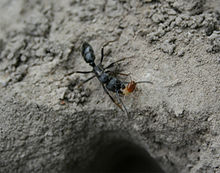
Ecologically, termites are important in nutrient recycling, habitat creation, soil formation and quality and, particularly the winged reproductives, as food for countless predators. The role of termites in hollowing timbers and thus providing shelter and increased wood surface areas for other creatures is critical for the survival of a large number of timber-inhabiting species. Larger termite mounds play a role in providing a habitat for plants and animals, especially on plains in Africa that are seasonally inundated by a rainy season, providing a retreat above the water for smaller animals and birds, and a growing medium for woody shrubs with root systems that cannot withstand inundation for several weeks. In addition, scorpions, lizards, snakes, small mammals, and birds live in abandoned or weathered mounds, and aardvarks dig substantial caves and burrows in them, which may then become homes for animals such as hyenas and mongooses.
As detritivores, termites clear away leaf and woody litter and so reduce the severity of the annual bush fires in African savannas, which are not as destructive as those in Australia and the U.S.A. Their role in bioturbation on the Khorat Plateau is under investigation.
Globally, termites are found roughly between 50 degrees north and south, with the greatest biomass in the tropics and the greatest diversity in tropical forests and Mediterranean shrublands. Termites are also considered to be a major source (11%) of atmospheric methane, one of the prime greenhouse gases. Termites have been common since at least the Cretaceous period. Termites also eat bone and other parts of carcasses, and their traces have been found on dinosaur bones from the middle Jurassic in China.
Plant defences against termites
Many plants have developed effective defences against termites, and in most ecosystems, there is an observable balance between the growth of plants and the feeding of termites. Defence is typically achieved by secreting anti-feedant chemicals (such as oils, resins, and lignins) into the woody cell walls. This reduces the ability of termites to efficiently digest the cellulose. Many of the strongly termite-resistant tree species have heartwood timber that is extremely dense (such as Eucalyptus camaldulensis) due to accretion of these resins. Over the years there has been considerable research into these natural defensive chemicals with scientists seeking to add them to timbers from susceptible trees. A commercial product, “Blockaid,” has been developed in Australia and uses a range of plant extracts to create a paint-on nontoxic termite barrier for buildings. In 2005 a group of Australian scientists “discovered” (announced) a treatment based on an extract of a species of Eremophila that repels termites. Tests have shown that termites are strongly repelled by the toxic material to the extent that they will starve rather than consume cross treated samples. When kept close to the extract, they become disoriented and eventually die. Scientists hoped to use this toxic compound commercially as a soil barrier but it failed field testing.
Taxonomy, evolution, and systematics
Recent DNA evidence has supported the hypothesis, originally based on morphology, that termites are most closely related to the wood-eating cockroaches (genus Cryptocercus), to which the singular and very primitive Mastotermes darwiniensis shows some telltale similarities. Most recently, this has led some authors to propose that termites be reclassified as a single family, Termitidae, within the order Blattodea, which contains cockroaches. However, most researchers advocate the less drastic measure of retaining the termites as Termitoidae, an epifamily within the cockroach order, which preserves the classification of termites at family level and below.
Evolutionary history
The oldest unambiguous termite fossils date to the early Cretaceous, although structures from the late Triassic have been interpreted as fossilized termite nests. Given the diversity of Cretaceous termites, it is likely that they had their origin at least sometime in the Jurassic. Weesner believes that Mastotermitidae termites may go back to the Permian and fossil wings have been discovered in the Permian of Kansas which have a close resemblance to wings of Mastotermes of the Mastotermitidae, which is the most primitive living termite. It is thought to be the descendant of genus Cryptocercus, the wood roach. This fossil is called Pycnoblattina. It folded its wings in a convex pattern between segments 1a and 2a. Mastotermes is the only living insect that does the same,
It has long been accepted that termites are closely related to cockroaches and mantids, and they are classified in the same superorder ( Dictyoptera), but new research has shed light on the details of termite evolution. There is now strong evidence suggesting that termites are really highly modified, social, wood-eating cockroaches. A study conducted by scientists has found that endosymbiotic bacteria from termites and a genus of cockroaches, Cryptocercus, share the strongest phylogenetical similarities out of all other cockroaches. Both termites and Cryptocercus also share similar morphological and social features—most cockroaches do not show social characteristics, but Cryptocercus takes care of its young and exhibits other social behaviour. As mentioned above, the primitive giant northern termite (Mastotermes darwiniensis) exhibits numerous cockroach-like characteristics, such as laying its eggs in rafts and having anal lobes on the wings that are not shared with other termites.
Systematics
As of 1996, about 2,800 termite species are recognized, classified in seven families . These are arranged here in a phylogenetic sequence, from the most basal to the most advanced:
- Mastotermitidae (1 species, Mastotermes darwiniensis)
- Hodotermitidae (3 genera, 19 species)
- Hodotermitinae Desneux, 1904
- Kalotermitidae (22 genera, 419 species)
- Termopsidae (5 genera, 20 species)
- Termopsinae Holmgren, 1911
- Porotermitinae Emerson, 1942
- Stolotermitinae Holmgren, 1910
- Rhinotermitidae (14 genera, 343 species)
- Coptotermitinae Holmgren
- Heterotermitinae Froggatt
- Prorhinoterminae Quennedey & Deligne, 1975
- Psammotermitinae Holmgren
- Rhinotermitinae Froggatt
- Stylotermitinae Holmgren, K & N, 1917
- Termitogetoninae Holmgren
- Serritermitidae (1 species, Serritermes serrifer)
- Termitidae (236 genera, 1958 species)
- Apicotermitinae Grassé & Noirot, 1954 (42 genera, 208 species)
- Foraminitermitinae Holmgren, 1912 (2 genera, 9 species)
- Macrotermitinae Kemner, 1934 (13 genera, 362 species)
- Nasutitermitinae Hare, 1937 (80 genera, 576 species)
- Sphaerotermitinae Engel & Krishna, 2004 (1 species)
- Syntermitinae Engel & Krishna, 2004 (13 genera, 99 species)
- Termitinae Latreille, 1802 (90 genera, 760 species)
The most current classification of termites is summarized by Engel & Krishna (2004).
Termites and rock music
The story that termites like rock music is based on the fact that the insects respond favourably to wood that is vibrated at certain frequencies. Termites respond to particular frequencies because such enduring vibration would normally signal to a termite that others have found, approved of, and already started eating a block of wood.
The story that termites 'like' rock music was popularized by Snapple "Real Fact"s (facts that appear under the bottle caps of the company's juice glasses). The idea dates further back to an article in Miami News from 1968. The article describes the work of entomologists Dr. Trenchard Bowelson and his Masters' degree student Jeanne N Collier. The two operated a pest control consultant's service in California. The entomologists first decided to conduct their studies after some students showed them termites who "looked like they might have had too much rock 'n' roll". Bowelson and Collier found that termites responded to the American Steve Miller Blues Band and especially to British rock band Spooky Tooth by eating voraciously, neglecting to go and share food with their larvae and queen (to the detriment of the colony). Bowelson realized that rock music may be a way to "undermine their social organization". However, whether the termites actually "like" the rock music (in the sense that they can derive any happiness from it) remains a mystery.

